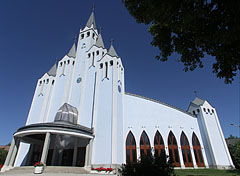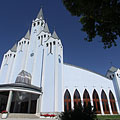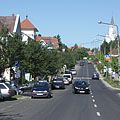 Τουριστικές πληροφορίες
Τουριστικές πληροφορίες
(Βελτιστοποιημένη για συσκευές με μικρή οθόνη)

Hévíz
A city with volcanic water
A city with volcanic water
that works wonders
that works wonders
The city was named after its hot-water thermal springs. The world’s largest medicinal lake with volcanic origins can be found here. Only New Zealand can be proud of such a lake of similar size. People hoping to be cured are attracted not only by this hot-water lake and its 50 hectare forest, but the city’s climate is almost Mediterranean with a relatively higher average temperature than the rest of Hungary. The city’s medical tourist industry is more than 200 years old.

The area around the lake was inhabited even in the Roman times. During excavations the ruins of a Roman villa were discovered. The area used to be marshy owing to the water coming from the lake. During the 17th century operations were carried out to set up mills and exploit the possibilities offered by the water. The hot water was utilized by the leather industry as well. The medicinal significance of the lake was discovered at the end of the 18th century.
The thermal lake and bath of Hévíz (Tófürdő)

On colder mornings, this hot-water lake is covered by steam, which prevents the lake from cooling down. This way it is possible to bathe in it during the whole year. Its beauty is made more striking by the Indian white and red water lilies floating on the surface, brought here by Sándor Lovassy in 1898. The lake is 38 metres deep and 86 million litres of water erupt daily from the many thousand year old karst springs, which are of different temperature. When bathing, your body is covered with bubbles, during which minerals stick to the skin and provide healing effects. Its Sulphur content makes it possible to cure Rheumatic problems and sports injuries.

The bath at Hévíz was established at the end of the 18th century, and the use of the water for medical purposes is attributed to György Festetics. The bath was supplemented with its twin-towered entrance during the 20th century. Not far from here two houses were built, still functioning under the name of ’Hetesház’. Among the huge sycamore trees of the Schulhof Promenade, leading to the lake, visitors can find different works of art. It is also possible to have a nice walk on the way-marked roads in the forest, breathing in the clear healthy air.
The Holy Spirit Church (Szentlélek-templom)

The Church was built in the years between 1996 and 1999 to the plans of architect János Bocskai, mixing the Gothic and modern style. The old church was located on the outskirts of the city. It proved to be too small, in spite of the several enlargementsand it was not easy to approach. Beside the two old bells, it received two new ones as well, which were made in Őrbottyán. Its tower symbolises the gifts of the Holy Spirit (Wisdom, Sense, Knowledge, Humbleness, Strength, Good Advice and Fear of God). From an aerial view, the church itself stands for the Holy Spirit as well with its shape of a dove with spread wings.

The stone church of the Árpád era (Egregy)
The stone church in Roman style built in the 13th century and mentioned for the first time in 1341, is really worth a visit. It is a good example of the small churches made of sandstone which were quite popular here. Its tower is topped by an octagonal cap. The road near the church leads to a late Roman grave from the 4th century, which should be visited as well.
Ruins form the Roman era (Egregy neighborhood)

It became clear after archaeological excavations that the area was inhabited until the end of the 5th century, and the finds are exhibited here. Built here in the 2nd century was a stone house, of more than 1000 square metres, and it even had a pool with cold, lukewarm or hot water. A Mithras altarpiece was set up in the 3rd century, the altar stone of which was found by archaeologists. In the 4th century the building was destroyed, but later, in the 5th century it was re-built and used for economical purposes.
Χαρακτηριστικά, ιδιότητες
Τύπος:
Μικρή πόλη, κωμοπόλη
Τοποθεσία:
Ευρώπη (Ήπειρο) > Ουγγαρία (Χώρα) > Βαλάτων (Τουριστική περιοχή) > Εθνικό Πάρκο Balaton-felvidék (Γεωγραφική περιοχή) > Zala megye (county) (Κομητεία)
GPS συντεταγμένες: Πλάτος 46°47'26", Μήκος 17°11'3" (N46 47.43 - E17 11.05)
Hévíz - Άλμπουμ φωτογραφιών, γκαλερί εικόνων (150 φωτογραφίες / 2 γκαλερί)
Hévíz - Πανοραμικές εικόνες (1 φωτογραφίες)
Μπορεί επίσης να σας ενδιαφέρει (Σχετικές σελίδες):
Προορισμοί στον ταξιδιωτικό οδηγό:
Hévíz (150 φωτογραφίες + 1 πανόραμα φωτογραφίες)
Zala megye (county) (354 φωτογραφίες + 12 πανόραμα φωτογραφίες)
Εθνικό Πάρκο Balaton-felvidék (440 φωτογραφίες + 15 πανόραμα φωτογραφίες)
Βαλάτων (1 597 φωτογραφίες + 35 πανόραμα φωτογραφίες)
Ουγγαρία (27 287 φωτογραφίες + 163 πανόραμα φωτογραφίες)
και επιπλέον:
(μέσα εδώ: Εθνικό Πάρκο Balaton-felvidék και Zala megye)
Balaton υψίπεδα (Balaton-felvidék) (123 φωτογραφίες + 5 πανόραμα φωτογραφίες)
Kis-Balaton
Kis-Balaton
Tihany (106 φωτογραφίες + 1 πανόραμα φωτογραφίες)
Balatongyörök (8 φωτογραφίες)
Kehidakustány (31 φωτογραφίες)
Keszthely (100 φωτογραφίες + 8 πανόραμα φωτογραφίες)
Zalakaros (43 φωτογραφίες + 3 πανόραμα φωτογραφίες)
Keszthely (100 φωτογραφίες + 8 πανόραμα φωτογραφίες)
Zalaegerszeg (22 φωτογραφίες)
Κάθε πανοραμική φωτογραφία στη:
Hévíz (1 φωτογραφίες)
Zala megye (county) (12 φωτογραφίες)
Εθνικό Πάρκο Balaton-felvidék (15 φωτογραφίες)
Βαλάτων (35 φωτογραφίες)
Ουγγαρία (163 φωτογραφίες)
Ευρώπη (165 φωτογραφίες)
Όλες οι κανονικές φωτογραφίες στη:
Hévíz (150 φωτογραφίες / 2 γκαλερί)
Zala megye (county) (354 φωτογραφίες / 9 γκαλερί)
Εθνικό Πάρκο Balaton-felvidék (440 φωτογραφίες / 13 γκαλερί)
Βαλάτων (1 597 φωτογραφίες / 35 γκαλερί)
Ουγγαρία (27 287 φωτογραφίες / 462 γκαλερί)
Ευρώπη (30 494 φωτογραφίες / 523 γκαλερί)
https://www.panadea.com/el/guidebook/heviz

Προσθήκη στα Αγαπημένα Προσθήκη στους Σελιδοδείκτες
Μοιραστείτε με τους φίλους σας!
κ.λπ.
Ταξιδιωτικός οδηγός μας περιέχει:
Πολυάριθμες φωτογραφίες και πανοραμικές εικόνες, με πολλές πληροφορίες και ενδιαφέροντα γεγονότα.
- 214 ταξιδιωτικοί προορισμοί
- 165 πανόραμα φωτογραφίες
- 30 494 άλλες φωτογραφίες
Μεγάλη συλλογή από επιλεγμένες φωτογραφίες: άριστη ποιότητα, υψηλή ανάλυση και φυσικά χρώματα
Σχετικά με εμάς - Αποποίηση ευθυνών -
Όλα τα δικαιώματα διατηρούνται
- ©2010-2022
Neuronit Creative Studio - Mogyoród / Βουδαπέστη / Ουγγαρία













